Menu
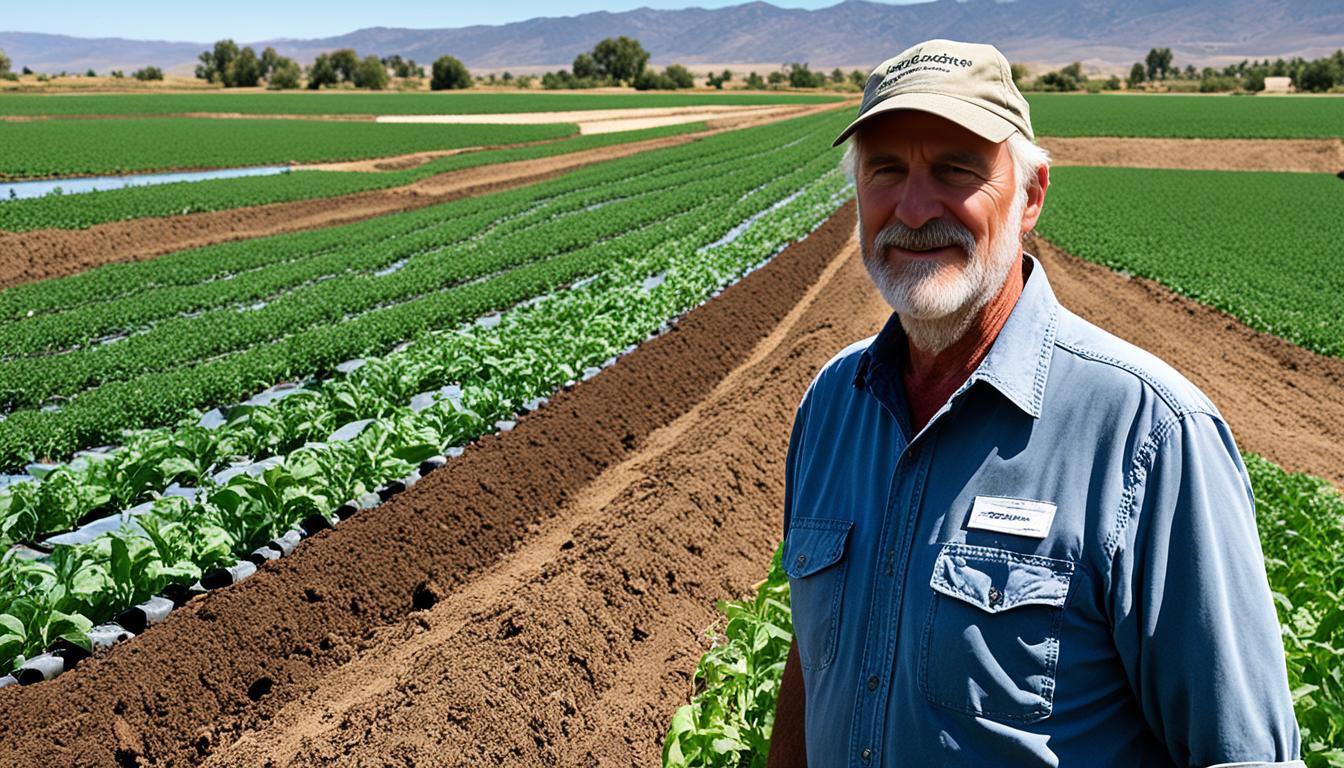
Did you know that irrigation has been a fine art for over 3000 years in mountain watersheds? This practice shows how crucial soil and water management is. In the West Himalayan cold deserts, ancient methods included using small channels, known as kuhls, to transport glacial water to crops. This not only highlights the historical knowledge but also how essential water saving and nutrient use have always been.
In areas like Himachal Pradesh, cold deserts are managed using ancient yet effective techniques. These include shared water systems and segmenting land to lessen water use. These methods prove the deep connection between soil health and water management. They are key to saving water, improving farming, and promoting agriculture that lasts.
Soil health is key to managing water and soil well. It includes the living, chemical, and physical parts of the soil. These create the perfect home for soil microbes, which help plants grow strong.
The qualities of soil are crucial for growing things. The MOSH, launched by BWSR in 2018, teaches people about soil health. They partner with the University of Minnesota to share knowledge.
Soil microbes are vital for soil and plant health. They eat up dead plants, making the soil healthy for new plants. MOSH helps farmers boost these tiny workhorses. They share data and tips for improving soil all over Minnesota.
Getting the right mix of stuff in soil is essential for crops to grow well. MOSH works on projects like the Minnesota Cover Crop Guide. They team up with experts and locals to improve how we take care of soil.
Sustainable farming uses many practices to protect the environment and make money. Three key methods include conservation tillage, rotating crops, and recycling organic matter. These are vital for keeping soil and water healthy over the long term.
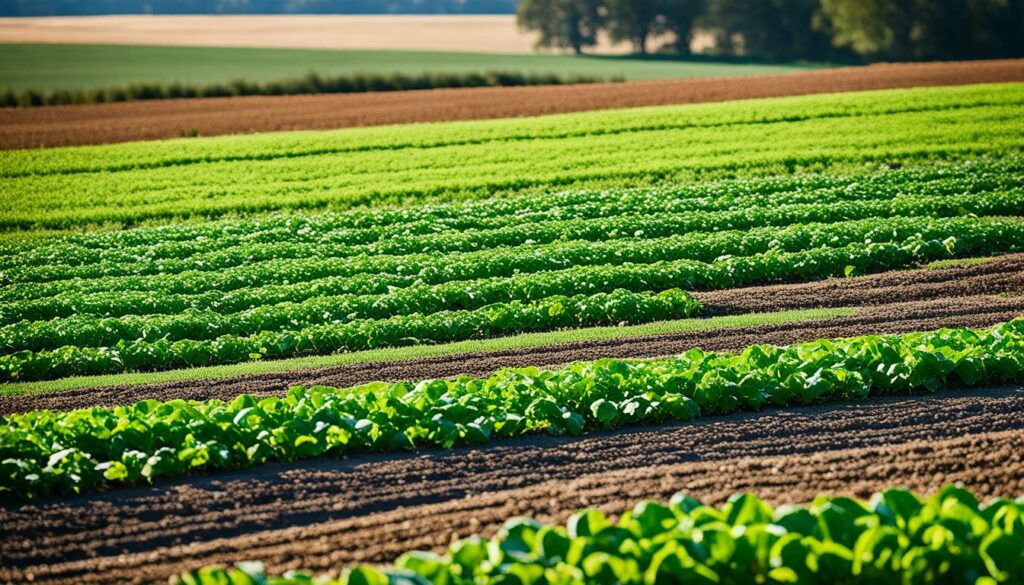
Conservation tillage is vital for farming that lasts. It cuts erosion, keeps soil healthy, and saves land. By disturbing the soil less, we help keep water and nutrients in place. In Illinois, a helpful program pays farmers to use these methods, decreasing soil loss by 60%. To get this support, farmers agree to protect the soil for ten years, ensuring long-lasting benefits.
“The adoption of conservation tillage practices can lead to a 60% reduction in soil erosion, according to the Conservation Practices Cost-Share Program,” says Dr. Sarah West from the Illinois Soil and Water Conservation District.
Changing the type of crops helps farming and the land. It makes the soil healthier and keeps pests away naturally. Different crops offer the soil various nutrients and help with soil quality and fertility. This creates a farming system that looks after itself and keeps producing crops.
Reusing organic waste helps stop soil erosion and makes the land more fertile. Adding compost, plant waste, and manure to the soil returns nutrients and supports helpful microbes. Good soil structure, rich in organic matter, can hold more water and reduce soil loss. This method lifts crop production now and for the future.
| Practice | Benefit | Longevity |
|---|---|---|
| Conservation Tillage | Erosion Control, Water Retention | 10+ Years |
| Crop Rotation | Improved Soil Structure, Pest Control | Ongoing |
| Organic Matter Recycling | Enhanced Soil Fertility, Microbial Health | Continuous |
Erosion control is vital for keeping soil and water in check. It’s key for good soil health and sustainable farming. Techniques like making bunds and terraces help fight different types of erosion. These include sheet, rill, and wind erosion. Using cover crops and planting smartly can lessen erosion’s effects.
Cover crops are like a shield against soil erosion. They make the soil better, hold more water, and stop runoff. Educational resources show how cover crops also help cycle nutrients. They make overall crop health better.
Keeping soil safe from too much digging is key to holding it together. Conservation tillage is one way to do this. It keeps the soil’s important parts from breaking up. This is really important on sloping land to stop erosion.
Using the right planting methods, like contour farming, is important for lessening erosion. These techniques can help save water and stop too much water in one place. Learning about terraces and gully treatments can help use these methods well.
| Erosion Control Methods | Details |
|---|---|
| Bunds | Includes contour bunds and graded bunds, crucial for directing water flow and reducing soil erosion. |
| Terraces | Bench terraces and broad-base terraces help in water management and prevent soil runoff. |
| Cover Crops | Protect soil surface, enhance water retention, and contribute to nutrient cycling. |
| Minimising Soil Disturbance | Conservation tillage preserves soil structure and organic matter, reducing erosion risk. |
| Planting Techniques | Utilising contour farming and strategic water harvesting structures to mitigate erosion. |
Looking after soil health through smart nutrient management is key. I work with soil chemistry to understand how nutrients move. This way, I make sure plants get the right nutrients they need when they need them. This approach helps crops grow well and protects the environment.
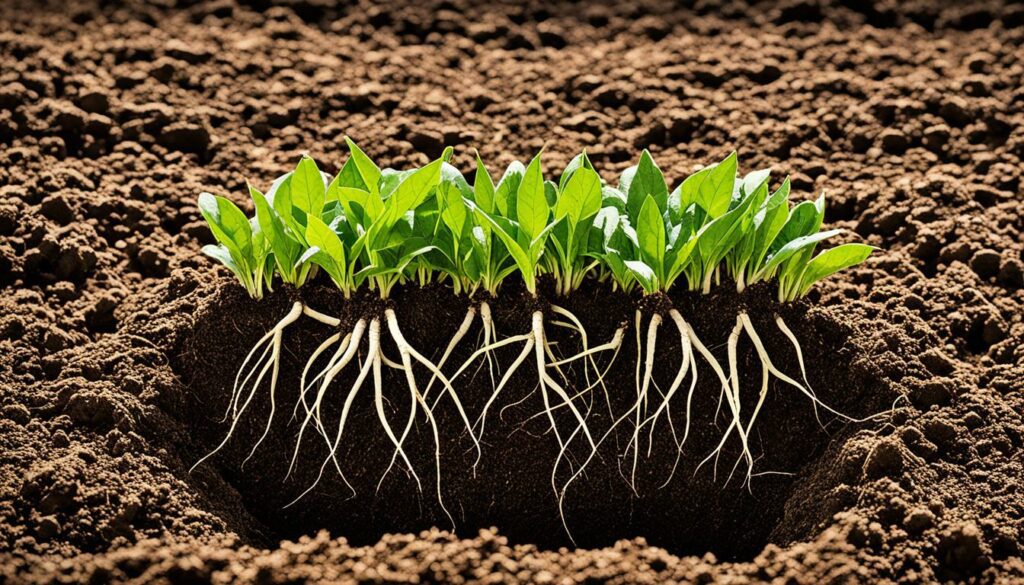
Managing soil nutrients means handling fertilisers, manure, and more. It’s all about making sure plants get the minerals they need to grow. But, too much of these elements can harm the environment. So, testing the soil helps me plan how to feed the plants without hurting the land.
Nutrient cycling is crucial for a healthy soil ecosystem. It’s how nutrients move from the soil into plants and back again. This process boosts the soil’s health, which is good for plants. Adding cover crops, compost, or manure can make a big difference. It helps nutrients move around better, making the soil and plants healthier.
Soil microbes are critical for releasing nutrients plants can use. They break down dead matter, releasing minerals. For example, plants like alfalfa can make a lot of nitrogen. Chemical fertilisers work fast to give plants nutrients, but they have downsides. They can be lost to the air if not used correctly. It’s important to balance using both microbes and chemicals for the best results in plant growth.
| Nutrient Source | Average Nitrogen Release (Year of Application) | Post-Application Nitrogen (Year 2) |
|---|---|---|
| Cow Manure (20-40 tons/acre) | 15 lbs/acre | Minimal |
| Poultry Manure | High release within 1 year | Moderate |
| Finished Compost | 5-15% | Approximately 90% locked in organic compounds |
| Legumes (e.g., alfalfa, red clover) | 100+ lbs/acre (biological fixation) | Assimilated by succeeding crops |
Advanced irrigation practices are key in modern farming. They help make water use sustainable and efficient. These systems can boost crop yield and minimise water use in different environments.
Drip irrigation systems are changing how we farm. They water plants right at their roots, cutting down on waste. Letting crops get just the right amount of water. The Colorado TAPS program in 2023 showed that drip irrigation helps farms produce more by using nitrogen and water well.
Getting the most out of water is vital for growing crops sustainably. New tech like plant sensors and soil tests are making irrigation more accurate. Four UC facilities in California are working together to study soil moisture and how water moves from plants to the air. This research helps farmers know exactly when and how much to water their fields.
Using advanced irrigation can really increase crop yield. The Colorado TAPS program found that the most successful farms were the ones using their resources wisely. Platforms like HydraCarta use data from space to monitor and adjust water use. This can improve how water is used, boosting crop yield around the world.
| Year | Study Focus | Key Findings |
|---|---|---|
| 2018-2020 | Biochar Impact in Utah | Soil-incorporated biochar increased silage corn yield by 12% in 2018 but reduced 10% in 2019 at 22 Mg ha-1 rate |
| 2023 | Colorado TAPS Program | Top-yielding teams were the most input-use efficient in nitrogen and irrigation applications |
| 2018-2020 | Biochar Impact on Alfalfa | Top-dressed biochar had no impact on alfalfa yield, regardless of irrigation rate |
Using advanced ways to water farms not only saves water but also boosts the crops we grow. It supports sustainable farming.
Soil testing is crucial for effective management by shedding light on soil chemistry and nutrients. It gives insights into the soil’s physical properties too. With regular testing, decisions improve, crop production is enhanced, and the environment stays protected.
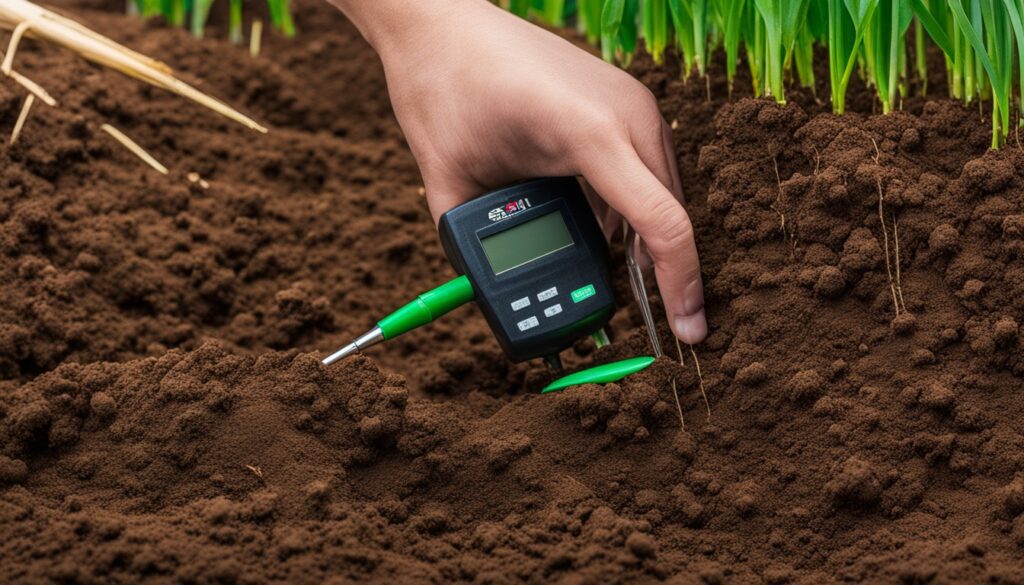
Testing soil chemistry helps spot nutrient shortfalls, pH issues, and too much salt. For those who blend their media, like greenhouse growers, it’s particularly important. There are different testing methods, each giving different results. But, keeping procedures the same is key to accurate tests.
The Haney test helps evaluate soil nutrient levels and health for crop support. It’s wise to pick samples from various parts of a field. Testing soil after fertilising, or on the fertilising day, ensures precise results. Also, comparing samples from normal and abnormal plants is vital.
Checking soil for compaction and drainage tells a lot about its health. Monitoring pH and electrical conductivity in growing media is smart, at least monthly. It helps control nutrition and salts. But, remember to sample correctly and label samples well to make the most of testing.
Understanding soil testing results is key. Using the right methods and learning from past studies is crucial to avoid mistakes. This approach helps manage nutrients better, save money, and protect the environment from overuse of fertilisers. It’s all about making smart, well-informed decisions.
Crop rotation is key in farming for keeping the soil fertile and diverse. It stops soil from losing key nutrients. This happens when you plant a variety of crops. It helps support the health of the soil overall.
One compelling statistic to consider is that 40% of eroded soil in the Midwest goes into water bodies. This can make pollution worse. Crop rotation helps by lowering soil erosion and keeping the top layer of soil healthy. Plants like maize and hay are great for stopping soil from being washed away.
Studies show that mixing up the crops you grow can be really beneficial. For example, farmers who grew three or four different crops over ten years made more money and had better yields. In one study, using a two-year rotation led to a 29% better corn harvest than planting the same crop over and over.
| Benefit | Statistic |
|---|---|
| Improved Crop Yield | 29% increase in corn yield |
| Reduced Soil Erosion | Mitigates 40% of eroded soil runoff |
| Enhanced Profits | Higher profits with diverse crops |
Different crops play a big role in making the soil diverse. They help create a good environment for beneficial microbes. This can lead to lower soil compaction. With less compaction, seeds can grow and roots can spread more easily. This means farms can use water better, which is important in dry times.
Growing legumes as part of crop rotation boosts soil fertility by adding nitrogen to the soil. This cuts down on the need for man-made fertilisers. Also, rotating crops can stop pests and diseases from spreading. This helps the crops grow better and reduces risks in the long run.
Although crop rotation requires good knowledge of plants, it’s great for farm success. It’s especially useful when times are tough financially. Using these proven methods helps keep farming strong and productive.
Water quality monitoring is key in farming to keep water clean for crops and control sediment in waterways. It looks at things like pH, electrical conductivity, and TDS to gauge their effect on farming and nature.

Keeping water clear of sediment is vital for life in streams and effective farming. Excess sediment harms waters by lowering oxygen and adding too many nutrients. This leads to too much algae. In Iowa, 91 water bodies are hurt by sediment. This shows the need for limiting soil erosion to help water quality.
Having clean water for crops is essential. Checking river pH, which should be 6.5 to 8, keeps conditions good for freshwater life that helps crops. Groundwater also needs testing because it can have too many solids and harm crops. The Colorado River Basin loses $300,000 to $500,000 yearly due to too much salt. This shows why we need to keep a close eye on water quality.
Good water quality monitoring looks at TDS and electrical conductivity too. These show how much salt is in the water. We also watch nutrients like nitrogen and phosphorus. They are needed for life but can cause trouble if there’s too much. Problems like harmful algal blooms and low oxygen can happen.
| Parameter | Measurement | Impact |
|---|---|---|
| pH | 6.5 to 8 | Maintains freshwater organism habitats |
| Electrical Conductivity | Measured in microsiemens per centimeter (mS/cm) | Indicates dissolved salts |
| Total Dissolved Solids (TDS) | Varies with water body | Overall water quality |
| Nutrients (N, P) | Measured in mg/L | Essential for growth but harmful in excess |
Integrating water quality monitoring into farming practices helps manage resources better. It lowers sediment and ensures water is good for crops and farm growth.
Adding biochar to soil management is a game-changer. It’s great for improving soil fertility and keeping water in. Plus, it helps reduce where heavy metals move. All this makes it amazing for farming that looks to the future.
Biochar stays in the soil for over 2,500 years. This is longer than most organic materials. Its presence boosts soil health in big ways. It helps with essential processes like the cycle of nutrients and the work of tiny microbes.
This can up crop growth by up to four times in soils with little organic matter. Also, when mixed with fertiliser, biochar makes the soil perform 60% better than with fertiliser alone. This shows how biochar and other soil helpers can work together really well.
One great thing about biochar is it can help soil hold more water. This happens because of its special structure and form. It can increase the soil’s ability to keep water. For places with sandy soil, biochar brings more water to the plants.
But remember, the kind of material biochar comes from and how it was made can affect how well it helps keep water.
Biochar is a hero when it comes to stopping heavy metals from spreading in the soil. Its large surface and the way its parts are shaped can lock up harmful metals. This makes them less likely to hurt plants or to leak into water.
So, by using biochar in managing soil, we make the land safer and more productive. This helps farming and keeps the environment healthy.
In my search for sustainable agriculture, controlled traffic farming stands out. It involves carefully controlling where farm machinery goes. This approach tackles key issues in farming today.
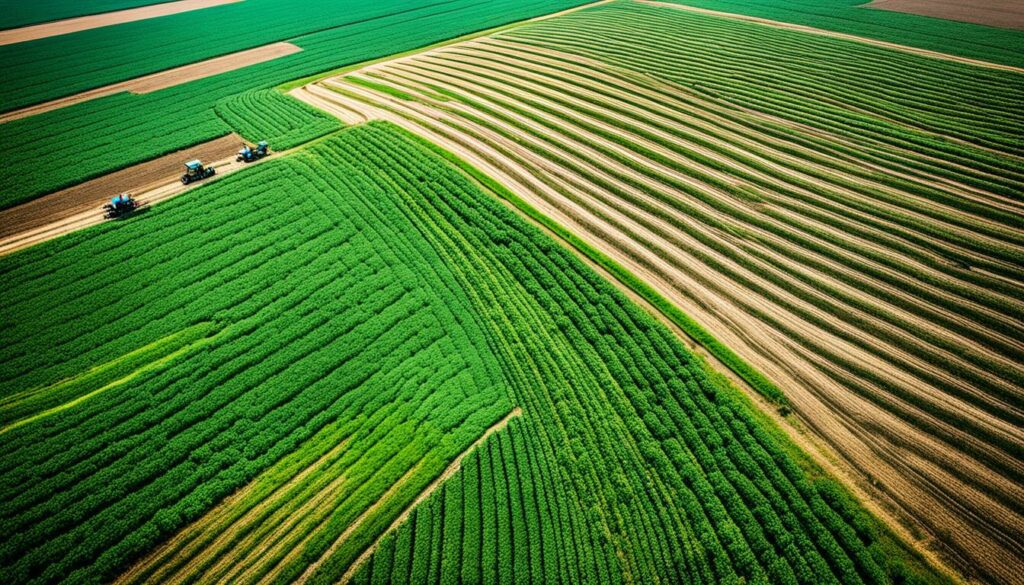
Controlled traffic farming greatly cuts down on soil compaction. Normally, up to 75% of the soil’s condition suffers after one season. This worsens to a full 100% by the second season from repeated machinery use. However, controlled traffic limits this to just 15% in the first season. Use of wider vehicles can lower this to under 10%, even without satellite technology. This is a big boost for soil health.
A key focus is getting the traffic patterns right. With technologies like GPS and auto-steer, controlled traffic farming reaches a high level of precision, almost ± 2 cm. This means less overlap between passes, making work more efficient. For growing vegetables, there’s room to adjust track widths. They can range from 1.83 m to systems over 3.2 m wide, ensuring the best efficiency.
Controlled traffic farming deeply impacts soil health. It maintains soil structure and reduces erosion and compaction. Switching to this method might need new farming ways and special technology. But the results are worth it. You get better crops, need less planting material, save on fuel, and improve soil health. An Australian study found farmers made more money per hectare. Half of this profit came from better yields and grain quality.
| Aspect | Traditional Farming | Controlled Traffic Farming |
|---|---|---|
| Soil Area Affected by Machinery | 75% in one season, 100% in two seasons | 15% reduction |
| Pass-to-Pass Accuracy | – | ± 2 cm |
| Overlap Reduction | – | 10% reduction |
| Soil Compaction | High | Low |
| Fuel Usage Reduction | – | 25%-50% reduction |
| Yield Improvement | – | Up to 25% increase |
It’s key to know the role of organic carbon in soil for better farming. Organic carbon keeps soil healthy and helps crops grow well. It also fights climate change. Learning to boost soil organic carbon (SOC) levels shows its huge perks for nature and farming.
More organic carbon in soil helps a lot in tackling climate change. SOC acts like a sponge, taking in carbon dioxide from the air. This reduces harmful gas emissions, improves soil’s health, and makes it stronger. Not ploughing too much and planting cover crops guard carbon and stop soil washing away. Also, changing what crops you plant boosts the helpful bacteria in the soil, making better use of SOC.
Good amounts of organic carbon in soil make soil structure better. Almost 58% of soil’s organic matter is carbon, making it a vital part. Better SOC management makes soil firmer, more resilient to dry spells and floods, and less likely to wash away. Adding compost to the soil is a great way to raise SOC, especially with enough water around.
More organic carbon in soil means crop yields get better. Enough SOC gives crops the nutrients they need, helping them grow strong. This boosts profits for farmers and cuts their costs. Cover crops keep the soil’s bugs active, stop erosion, and save food for future plants. Products like AgriGro’s IgniteS2® and FoliarBlend® make the soil’s tiny life better, upping crop yields and SOC too.
Bringing soil and water management together is key for supporting farming for the long term. Most of our food – more than 95 percent – comes from soil and water. So, it’s vital to protect these resources. This helps farming be more efficient and keeps the environment healthy.
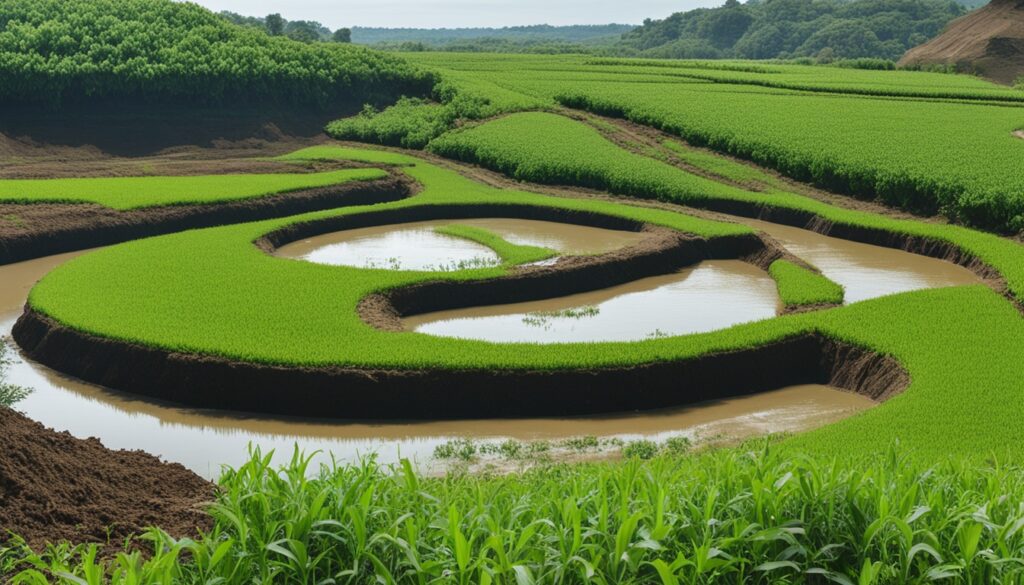
To farm sustainably, we must look at soil and water management as one. For example, in India, half of the area used for crops depends only on rain. This feeds 40 percent of the country. By managing soil and water better, farmers can improve soil health. They can also stop the degradation of nearly a third of India’s land.
Managing soil and water well has many benefits, especially for our water. Bad practices can make soil wash away, lower biodiversity, and pollute water. But using good methods like rotating crops and adding organic matter can help. The FAO is helping India use tools to help farmers use water better, making it cleaner and more stable.
The effects reach far and wide. For example, the FAO has worked in places like Andhra Pradesh, Karnataka, and Maharashtra in India. They’ve shown that looking after the soil well can do two things. It can make farms better and help meet global environmental goals. By working on things like crop variety, these efforts are helping a lot. Plus, India is also focusing on soil biodiversity to stop soil loss and damage.
“Effective soil and water management practices can have a transformative global impact, mitigating soil erosion, enhancing water quality, and bolstering food security.”
Looking after soil and water well doesn’t just help one country. It pushes for worldwide teamwork on good farming. In India, over 3 billion tonnes of soil are lost each year. This shows the urgent need for better, combined ways to farm. It’s the path to a strong future for farming everywhere.
Adapting to climate change is key for resilient farms and a green planet. Farming uses a lot of the world’s water, so we need clever soil plans to save water and make farms stronger. A big study found that joining knowledge about water, farming, and soil helps us fight climate change better.
Soil can help fight climate change if we use it right. Things like stopping soil from washing away, keeping it moist, and using water wisely help us deal with bad weather. Changing how we farm, what water we use, and what plants we grow shows we can face up to climate change.
In Europe, ways to look after the soil have made a big difference. They’ve made the soil healthier and stopped it from blowing or washing away. These steps show that solving problems locally is important. By using water smartly and reusing water, farmers can look after their crops even when times are tough.
Climate change adaptation requires a multidisciplinary approach that integrates soil and water management practices to sustain agricultural productivity and safeguard environmental sustainability.
Small changes on the farm, like planting at different times and keeping soil moist, are good for the earth. These changes make the soil stronger and help it deal with the bad effects of climate change. They also protect the important nutrients in the soil.
Helping the earth through farming not only helps the farms but also the world. Thinking about big global goals (like feeding everyone, fighting climate change, and protecting nature) helps our efforts. In the end, smart soil management is at the heart of strong farming that can cope with climate change.
| Adaptation Strategy | Benefits | Implementation Areas |
|---|---|---|
| Smart Irrigation | Optimises water use, enhances crop yield | Asia, Africa, Europe, North and South America |
| Climate-Resilient Crops | Improves resilience to extreme weather, enhances soil health | Tropical and subtropical regions |
| Soil Moisture Conservation | Reduces water loss, improves soil structure | Europe, North America |
| Reallocating Water Resources | Ensures efficient water distribution | Global |
I’ve explored soil and water management best practices. It’s clear that using sustainable farming techniques is key. This boosts soil health and conservation efforts. In the Himalayas, farmers use small water channels, called Kuhls, for 85.83% of the irrigated area. Cold desert villages use glacial water from these channels. This method is an efficient way to use water across natural slopes, helping in sustainable farming.
In Himachal Pradesh, a unique approach to sharing water is in place. Local communities manage the water from Kuhls together. This ensures a fair share for all based on their land. Such local efforts prevent disputes and help crops grow well by ensuring they get water at the right times.
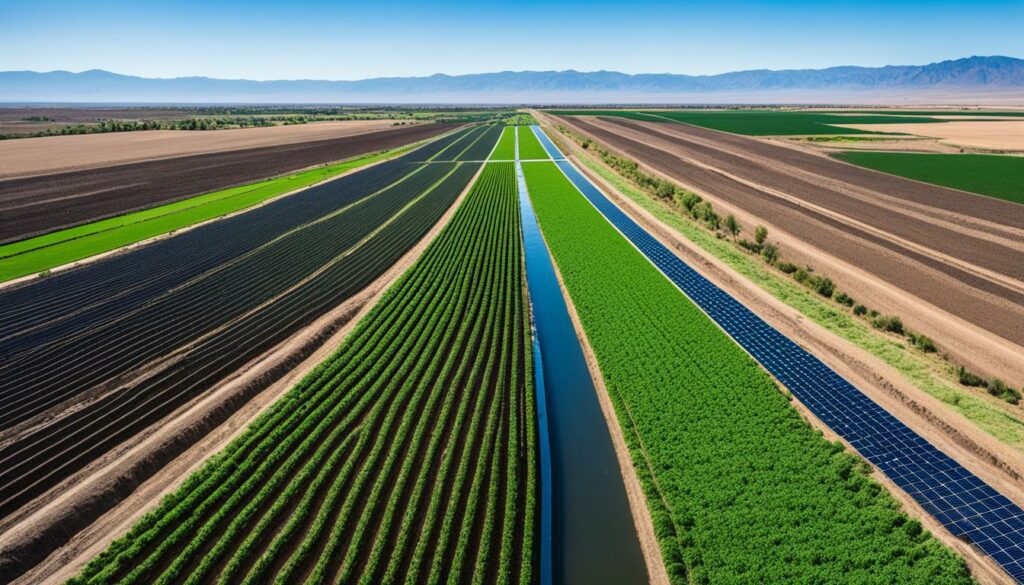
In the Spiti Valley, farmers stick to a strict irrigation plan. This plan is very detailed, focusing on the different growth stages of crops. It shows how careful planning can help get the best out of each drop of water, even in tough environments.
Many mountain areas face water shortages, which are a big worry for farms and life. Since a lot of farming relies on rain, conserving water is a must. Using water wisely and managing it well helps survive dry spells and is very important.
Below is a table that shows how irrigation methods work in different places:
| Region | Primary Irrigation Method | Effectiveness Factors | Challenges |
|---|---|---|---|
| Himalayas | Kuhls (water channels) | Natural gradients, community management | Water scarcity, rain dependency |
| Cold Deserts of Himachal Pradesh | Glacial water through kuhls | Collective operations, standardised irrigation schedules | Freezing temperatures, limited water sources |
| Spiti Valley | Standardised irrigation schedules | Specific crop growth stages management | Water scarcity, harsh climate |
Adopting these best practices needs an all-encompassing strategy. It should blend diverse sustainable farming techniques and innovation. This way, we not just save soil and water but also secure the future of farming in tough places.
Managing soil and water well is key as we farm and care for our planet. The UN says one fourth of farmable land is badly damaged, costing up to $577 billion yearly. While new farming ways can be expensive at first, over time, they save more than they cost. Practices like terracing, no-till farming, and planting trees help to keep our land and water healthy.
Global warming changes when and how much it rains, making droughts and floods more common. Without the right farming methods, the land can wash away faster. It’s up to farmers, communities, companies, and governments to work together. They can solve big problems like water pollution. This teamwork makes farming stronger and more sustainable.
Managing the amount of water in soil is very important for how well crops grow, especially where it’s dry. Only a tiny bit of the world’s water is right for plant growth. This makes careful water and soil use even more important. By knowing about soil types and what makes them hold water well, we can grow crops better.
In the end, looking after our land and water is crucial for farming in smart ways in today’s world. Choosing to use water and soil wisely, with new ideas and deep knowledge, sets us on a good path. With this approach, our farming future can be both successful and good for the Earth.
Effective practices include things like conservation tillage and crop rotation. They also involve using drip irrigation and recycling organic matter. These strategies are at the core of sustainable farming. They help keep the soil healthy and save water.
Soil health is vital as it supports life underground and helps plants grow. Good soil can store nutrients and water better. It also fights diseases naturally. This makes it key for farming that doesn’t harm the environment.
Conservation tillage keeps in more carbon, stops erosion and boosts soil nutrients. It does this by disturbing the soil less. This method holds in more natural matter and improves how the soil is made up.
Crop rotation is great for keeping the soil rich and healthy. It also fights off pests and diseases. Plus, it adds variety to the crops you grow. This all helps the land stay productive for the long term.
Recycling stuff like leftover plants and compost helps soil stay full of nutrients. It also makes the soil better at holding water. This helps the tiny life forms that live in soil too. All these are key for keeping the land and water in good shape.
Keeping the soil safe from washing away can be done by using cover crops and being careful not to disturb the soil too much. Planting in ways that stop the soil from eroding also works. These methods are essential for keeping the land sustainable.
Looking after nutrients is important as it keeps soil fertile and plants growing strong. Understanding how nutrients move in soil is key. This helps the land grow food well and without harm.
Drip systems save water by putting it right by the plants that need it. Less water is lost to the air or runoff. This boosts how much food you can grow and keeps the soil and water in good shape.
Soil tests tell us a lot about what the land needs. They show how nutrients and the soil in general are doing. Tests like the Haney test also check if the soil can grow things well.
Biochar makes soil better at holding water and adds nutrients. It also stops heavy metals from spreading. Using it leads to healthier soil that can grow more food.
By limiting where machines drive, controlled traffic farming stops soil from getting packed too hard. This keeps the land ready for good crop growth. It also helps preserve the land’s natural state.
More organic carbon means healthier soil and more food. It also helps fight climate change and saves water. Such benefits show why keeping the soil full of organic matter is crucial.
By looking after both the soil and water, farming can keep going without harm. This is important for the whole planet. A joint effort in farming can protect our environment and keep food coming.
Looking after the soil makes farming stronger against the changing climate. This means we can keep growing food in a way that doesn’t hurt the planet over time.
Good methods include ways to farm that take care of the soil. This involves keeping the soil covered and using smart watering techniques. Such practices are vital for lasting farming success and keeping our planet healthy.